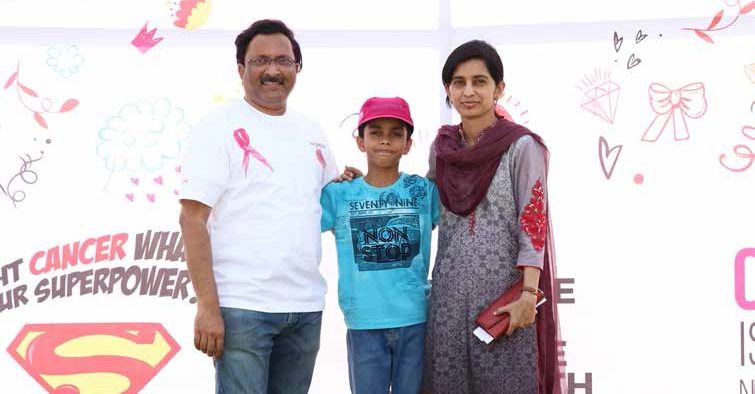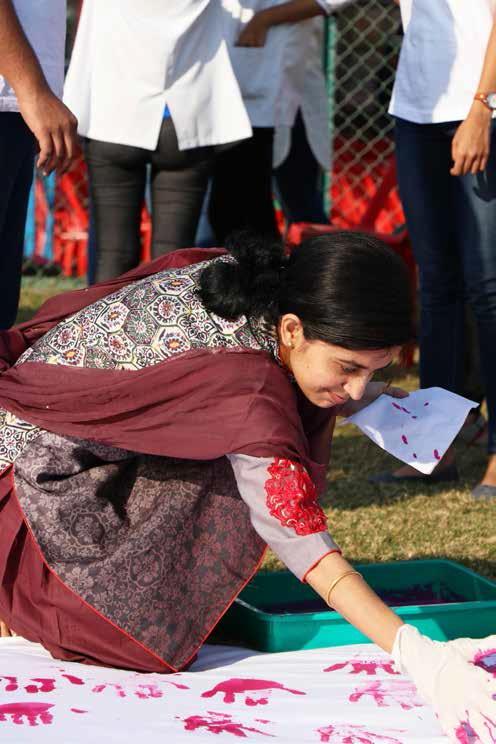Towards A Cancer-Free India


The students of Krishna Institute of Medical Sciences, Karad, joined hands with Zuvius Lifesciences for this year’s start to the Pink Street campaign. The campaign, which was held on February 3, made it to the news for its record-making attempt to create India’s largest handprinted cancer awareness ribbon. WeCanServe catches up with renowned radiation oncologist Dr. Anand Gudur, who heads the institute’s department of oncology, and Dr. Rashmi Gudur, who is a medical oncologist at the institute.
How did the idea to collaborate with the Pink Street Campaign come up?
We work in a medical college hospital and we have a large number of students and doctors from other branches of the medical fraternity. We regularly do activities to drive home the message of cancer awareness among the students, because they are the medical professionals of the future. We knew about the theme of the Pink Street campaign being conducted by Zuvius Lifesciences, and we heard about the inaugural event at Symbiosis School of Economics, Pune. It had a fun element for students as well, as it was organized ‘by the students and for the students’.
What was the response towards the Pink Street campaign among the students and faculty of Krishna Institute of Medical Sciences?
The Pink Street Campaign created a wave of energy in the college campus. We got an enormous response from hundreds of students as well as from the faculty of medical, dental, physiotherapy and other allied science departments. They were more enthusiastic about participating because of the social cause and message behind the whole programme. The idea of being part of creating the country’s largest hand-printed cancer awareness ribbon also motivated them.
What are some of the other cancer awareness drives that happen at KIMS?
Creating awareness regarding a healthy lifestyle and keeping a check on preventable diseases is the need of the hour. We regularly conduct cancer awareness and detection camps in neighboring villages and hold lectures in schools and colleges regarding the ill effects of tobacco. Our efforts have gained momentum because of novel initiatives like the Cancer Sakshar Satara Abhiyan and the activities of Maharashtra Cancer Warriors.
Do you have other student-led social responsibility initiatives?
Students are actively involved in community-based awareness initiatives by creating street plays, skits, dramas, and short films. These are regularly played at various social groups and forums. They also join in to celebrate World Cancer Day and World No Tobacco Day. Medical interns actively participate in surveys and counseling sessions being held for patients and their relatives.
How effective are awareness programmes in terms of cancer prevention and increasing early detection?
Increasing awareness and fighting the stigma and fear attached to the word ‘cancer’ play a crucial role in reducing the burden of the disease in the long run. Since cure rates can be significantly better if detected early, improving the awareness among health care providers at all levels and among the general public through such activities is pivotal.
What more can the government or other agencies do in order to bring down the incidence of cancer?
Enforcement of strict laws regarding tobacco ban and spreading the message among school and college students will help bring down the incidence of cancer greatly. Screening programmes like mammography and Pap smear examination should be implemented and in this case, public-private partnerships will improve the penetrability. Government agencies have to work together with private institutions, NGOs and oncology centers in the prevention and early detection activities.
Dr. Anand, there has been a lot of technological advancement in radiotherapy in the last decade. How has this changed the treatment scenario?
During the past decade, the leap in radiotherapy technology has been overwhelming. The accurate targeting of tumors with maximal sparing of normal tissues has been the foremost goal of radiotherapy practice. The ability to achieve this goal has improved greatly through advances in imaging technology and computer technology, along with advances in radiation therapy equipment. Newer versions of Linear Accelerators and Treatment Planning Systems have fundamentally changed the processes of tumor targeting and radiation therapy planning. Technologies like 3D CRT, IMRT, IGRT, SRS/SRT have begun to show their usefulness in reducing toxicities significantly, improving tumor control and improving quality of life in cancer patients.
Dr. Rashmi, does target therapy benefit a patient more than chemotherapy?
Targeted therapy has its own benefits in terms of being more tumor-directed and less toxic than conventional chemotherapy. Using targeted therapy is based on the detection of an actionable target in the cancer cells and choosing an agent is always decided by calculating the risk-benefit ratio for that particular patient. The future of medical oncology looks quite promising and revolutionary, with so many newer agents being added every year. For now, the targeted therapies are useful as very powerful adjuncts to conventional chemotherapy. Although in certain situations, these are used instead of chemotherapy, it is too early to tell if they can completely replace traditional chemotherapy.
What is lacking in terms of cancer treatment and care in India?
Like most healthcare facilities, there is an inequitable distribution of oncologists, with rural India completely lacking in oncology services. Many patients have to travel to larger cities to access cancer treatment facilities. Cancer treatment in India is still considered unaffordable for the majority of the population.
Statistics say India is poised on the verge of a cancer epidemic. What can be done in order to ensure that proper care is reached out to all patients?
The government should work towards reducing discrepancies by strengthening cancer care facilities at the district level. This can be done by providing expertise in district hospitals and medical college hospitals. Increasing government funds allocated for cancer patients is an important step to ensure that no patient is denied treatment on financial grounds.
With two oncologists, your household would be a busy one. How do you both ensure you have a work-life balance?
Working in the same unit as colleagues also mean that we have so many decisions to be taken together. Being married for 14 years, we have reached a comfortable level of understanding now and this helps in streamlining our work in a more coordinated way. Striking a balance is not easy, but we make sure we spend quality time with our family.
What would be your message to the youth of the country, in terms of cancer prevention?
The youth of the nation is the future of any country. If we sow seeds of a healthy lifestyle in today’s youngsters, we reap the benefits in the coming years. The same is true for cancer awareness. Lifestyle norms like keeping away from addictions like smoking, exercising and having a healthy diet should be inculcated at a very early age
“SINCE CURE RATES CAN BE SIGNIFICANTLY BETTER IF DETECTED EARLY, IMPROVING THE AWARENESS AMONG HEALTH CARE PROVIDERS AT ALL LEVELS AND AMONG THE GENERAL PUBLIC THROUGH SUCH ACTIVITIES IS PIVOTAL.”
Dr Anand Gudur
Head, Oncology, Krishna Institute of Medical Sciences
















